Investigation of the Magnetosphere of Ganymede with Galileo's Energetic Particle Detector
Ph.D. dissertation by Shawn M. Stone, University of Kansas,
1999.
Copyright 1999 by Shawn M. Stone. Used with permission.
7.1 Feature G2-18:56:31, the Addition of Corotational Electric Field (continued)
The results for model M2 electrons and ions are quite similar and are presented in Figures 7.7 through 7.12 and summarized in Table 7.2. The results for channels A2 and A6, which are the same as A4, are presented in Appendix C. As can be seen in Figure 7.7, even up to 85% of full corotation, the effect on the ion absorption signatures is negligible. As with model M1, the low energy electrons are greatly affected. A pronounced anti-moon loss cone feature forms at 50% of full corotation for channel E1, but there is little effect at 25% as shown in Figures 7.9 and 7.8 respectively. Channel E3 shows a similar effect starting at 85% of full corotation, seen in Figures 7.10 and 7.11. The F2 energy channel is virtually unaffected as can be seen in Figure 7.12.
This result is significant because it shows that up to 25% corotation there is no effect on the observed absorption signatures. At values of 50% and above, anti-moon loss cone features begin to appear. The fact that these features do not appear in the real rate profiles indicates that it is unlikely that the corotational electric field, at least beyond 25% full corotation, makes it into the magnetosphere of Ganymede.
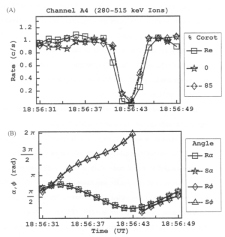 |
Figure 7.7 (A) Rate profile of model M2 energy channel A4 at .85 of full corotation for feature G2-18:56:31. At .85 of full corotation the A4 energy channel shows little effect. (B) The pitch and phase angles are computed from the look direction of the EPD detector and the appropriate magnetic field vector R for real and S for simulated. |
 |
Figure 7.8 (A) Rate profile of model M2 energy channel E1 at .25 of full corotation for feature G2-18:56:31. The loss cone feature is beginning to show effects at this value, but not much. (B) The pitch and phase angles are computed from the look direction of the EPD detector and the appropriate magnetic field vector R for real and S for simulated. |
 |
Figure 7.9 (A) Rate profile of model M2 energy channel E1 at .5 of full corotation. As with model M1, an anti-moon loss cone develops at .5 of full corotation. (B) The pitch and phase angles are computed from the look direction of the EPD detector and the appropriate magnetic field vector R for real and S for simulated. |
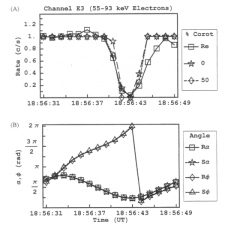 |
Figure 7.10 (A) Rate profile of model M2 energy channel E3 at .5 of full corotation. This channel shows little effect by .5 of full corotation. (B) The pitch and phase angles are computed from the look direction of the EPD detector and the appropriate magnetic field vector R for real and S for simulated. |
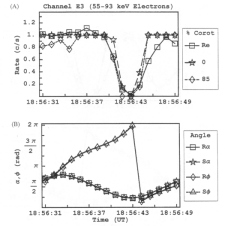 |
Figure 7.11 (A) Rate profile of model M2 energy channel E3 at .85 of full corotation. A loss feature begins to develop in the anti-moon direction. (B) The pitch and phase angles are computed from the look direction of the EPD detector and the appropriate magnetic field vector R for real and S for simulated. |
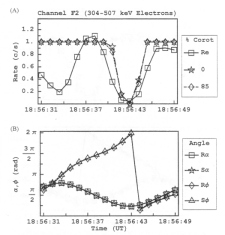 |
Figure 7.12 (A) Rate profile of model M2 energy channel F2 at .85 of full corotation. Even at .85 of full corotation the F2 energy channel shows little effect. (B) The pitch and phase angles are computed from the look direction of the EPD detector and the appropriate magnetic field vector R for real and S for simulated. |
Table 7.2 Addition of corotational electric field. Summary of Figures 7.7 through 7.12 for model M2.
| Figure | Information | Observation |
| 7.7 | Feature G2-18:56:31. Model M2 energy channel A4 at 85% of full corotational electric field. | There is no effect to the ions at this energy and value of corotational electric field. |
| 7.8 | Feature G2-18:56:31. Model M2 energy channel E1 at 25% of full corotational electric field. | The loss cone experiences a small amount of widening. |
| 7.9 | Feature G2-18:56:31. Model M2 energy channel E1 at 50% of full corotational electric field. | An anti-moon loss cone forms at 50% of corotation. It is quite pronounced at this value of corotational electric field. |
| 7.10 | Feature G2-18:56:31. Model M2 energy channel E3 at 50% of full corotational electric field. | There is no effect on channel E3 at this energy and value of corotational electric field. |
| 7.11 | Feature G2-18:56:31. Model M2 energy channel E3 at 85% of full corotational electric field. | A shallow anti-moon loss cone forms at 85% of corotation. |
| 7.12 | Feature G2-18:56:31. Model M2 energy channel F2 at 85% of full corotational electric field. | There is no effect on channel F2 at this energy and value of corotational electric field. |
A detailed particle trace will reveal exactly what is going on physically. Figure 7.13 presents a collimator pitch phase scatter plot for the trajectory pointed out in Figure 7.2. The simulation reveals that at 25% of full corotation there is virtually no change in the simulated signature. At 50% of full corotation, an absorption feature begins to take form at a pitch angle of 128°. An examination of the collimator pitch and phase scatter plot, Figure 7.14, reveals that a loss-cone indeed does result at an angle of 128°.
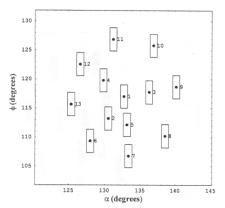 |
Figure 7.13 Collimator pitch and phase scatter plot for the sector pointed out in Figure 7.2 for M1 E1 G2-18:56:31 subenergy 37 keV at .5 of full corotation. The angles are in degrees. The filled in squares represent trajectories that intersected the surface of Ganymede and were absorbed. Open squares are trajectories that missed. |
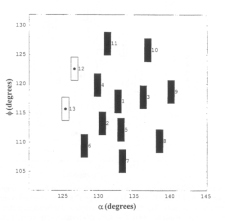 |
Figure 7.14 Collimator pitch and phase scatter plot for the sector pointed out in Figure 7.2 for M1 E1 G2-18:56:31 subenergy 37 keV at .25 of full corotation. The angles are in degrees. The filled in squares represent trajectories that intersected the surface of Ganymede and were absorbed. Open squares are trajectories that missed. |
Return to dissertation table of contents page.
Return to main
Galileo Table of Contents Page.
Return to Fundamental
Technologies Home Page.
Updated 8/23/19, Cameron Crane
QUICK FACTS
Mission Duration: Galileo was planned to have a mission duration of around 8 years, but was kept in operation for 13 years, 11 months, and 3 days, until it was destroyed in a controlled impact with Jupiter on September 21, 2003.
Destination: Galileo's destination was Jupiter and its moons, which it orbitted for 7 years, 9 months, and 13 days.



